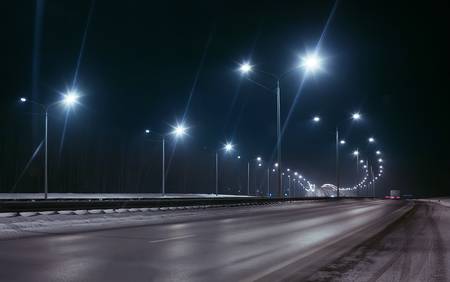Introduction to photocells, or Photo-Electric Control Units (PECUs); light operated switches. They switch the supply ON to a load when the light level falls beneath a given value (usually at Dusk), and switch the supply OFF when it rises above another level (usually at Dawn). The ratio between the two light levels is known as the switching ratio.
| Positive Ratio | When the ON level is lower than the OFF level (e.g if the load switched ON at 70Lux and switched OFF again at 105Lux, then the unit has a ratio of 1:1.5). As can be seen from Table 1, below positive ratio units have signifcantly longer annual burning hours than negative ratio units |
| Unity Ratio | When the ON and OFF levels are the same (1:1 ratio) |
| Negative Ratio | Most street lighting loads have a warm-up time during which the lamp achieves full brightness. This is typically a number of minutes, and the idea of negative ratio units is that the ON level needs to predict when the lamp will achieve suffcient output, whereas the OFF level is when the light is no longer needed. Typically a 1:0.5 ratio is ideal for this (e.g. turning ON at 35 Lux and OFF at 18 Lux). |
Energy Consumption
PECUs affect energy consumption in 2 ways:
PECU Consumption
The PECU consumes energy. The amount varies according to the technology used. Generally consumption is less than 5W (approx 44kWh/year) and many are less than 0.25W (which equates to
2.2kWh/year).
Burning Hours
Burning hours have the most dramatic effect on consumption. A further 100hrs/year on a typical 100W load results in an additional 10kWh/year consumption. Switching level, switching accuracy, and switching ratio.
Sensors used in PECUs
The most critical part of any PECU is the light sensor. The spectral sensitivity and long-term stability play an important role in providing reliable daylight detection. The below table further explains.
Comparison of sensors commonly used in PECUs
| Drift | Dusk Dawn Switching Repeatability | Spectral Sensitivity vs Photopic response | Other | ||
| Cadmium Sulphide (CdS) | Moderate | Moderate | Good | Contains Cadmium | |
| Photodiode Photo IC | Unfltered | Imperceptible | Excellent | Moderate | Insensitive to visible light |
| IR Filtered | Imperceptible | Poor | Very Poor | ||
| Glass Filtered | Imperceptible | Excellent | Excellent | ||
| DyeMatch Filtered | Imperceptible | Excellent | Excellent | ||
Cadmium Sulphide (CdS)
CdS sensors operate as light dependant resistors. They have conductivity approximately proportional to the level of light. They were the predominant sensor 20 years ago and are still sometimes used. It is very arguable whether CdS sensors meet RoHS requirements and they are also subject to some long term drift.
Photodiode Sensors
It is possible to construct a semiconductor diode to produce a current proportional to the incident light level. The currents generated are small and need careful amplifcation by a circuit that compensates for thermal effects. The fundamental physics of semiconductor junctions means that silicon photo-diodes have signifcant sensitivity to light outside the visible spectrum. Although semiconductor technology can limit this, other measures e.g. filters are needed for matching of sensitivity to that of the human eye. This is usually achieved by the addition of a flter that blocks light outside the visible spectrum. Filters can take a number of forms, but are usually bulk-coloured glass slips added to the photodiode assembly during manufacture.
The table below compares filtered and unfiltered photodiode sensitivity with eye sensitivity

A variant of the above is to add a flter that blocks all visible light, so that the photodiode is only sensitive to Infra red light. This can be incorporated into a PECU that is only sensitive to IR, and virtually insensitive to visible light. This means that the PECU can be used where it is partially illuminated by visible light, often produced by the light that is being controlled by the PECU.
There are 3 cautionary notes:
• Such PECUs can only be used with light sources that generate virtually no IR (Incandescent lamps generate huge amounts of IR)
• That the PECU, although insensitive to visible light, will still be affected by very high levels of visible light. The arrangement of the PECU within the luminaire should minimise such light.
• The proportion of IR to visible light in daylight varies with weather conditions so the PECU will not switch as accurately as a conventional PECU. An increase in annual burning hours of up to 25% can be expected.
Photodiode sensors can also be incorporated into integrated circuits providing an ideal format for digital processing of data from the sensor. Whilst many sensors include external flters it is also common to use two sensors, one sensitive to the full-spectrum the other with a flter. By careful processing of the output of these sensors it is possible to obtain phenomenally accurate sensors for measuring Lux.
Load switches
PECUs typically use one of three devices to switch the load:
• Thermal Relay
• Electromagnetic Relay
• Semiconductor
Thermal Relay
These relays are suited to use with CdS sensors. They have a number of drawbacks, principally power consumption and size. Today they are rarely used as load switches within lighting applications and have been replaced by products using other electronic devices, or electromagnetic relays. They operate by the action of a heating element on a bi-metal strip, as the strip deflects it causes contacts to make, or break.
Electromagnetic Relays
These relays are widely used in many applications. They are both small and capable of operation at low power. They are relatively poor at transferring high inrush loads (common to many streetlighting applications); this can be mitigated by techniques such as predictive load transfer.
Semiconductor
There are a number of semiconductor devices capable of switching streetlighting loads. Triacs are the most common, however Thyristors and MOSFETs have also been used. These devices are
reliable, simple to control, and have a good ability to transfer high inrush loads. It is relatively easy to implement zero-cross switching with semiconductor switches.
| Consumption | Load Switching Capacity | Load Holding Capacity | Size | |
| Thermal Relay | Poor | Moderate | Excellent | Large |
| Electromagnetic Relay | Moderate | Moderate | Excellent | Moderate |
| Semiconductor | Excellent | High | High | Small |
For more KnowHow on street lighting photocells please visit the related posts at the bottom of this page.


